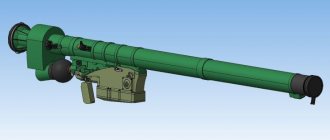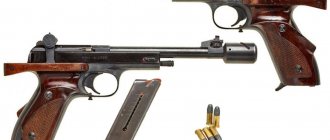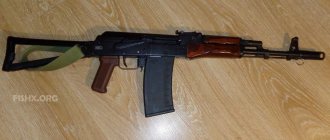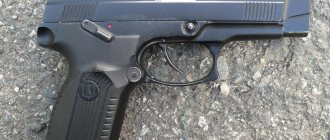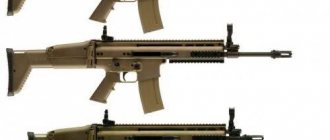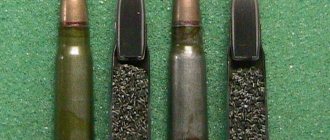When planes flew slowly, were built of wood and canvas, and were armed with conventional machine guns, infantry could even defend against them with rifles. But by the time of World War II, planes began to fly higher, faster, and attack from distances exceeding the effective range of infantry weapons.
The emergence and development of homing guided missiles helped change the situation. And in the 60s, portable anti-aircraft missile systems appeared that were capable of effectively hitting aircraft. “Igla” is one of the most famous modern representatives of such weapons.
History of creation
In the 60s, the Soviet Union adopted the Strela-2 MANPADS (essentially a direct copy of the American Red Eye complex). Deliveries of Strels to friendly regimes and “developing countries” began immediately. Over the next decade, she showed fairly high fighting qualities. But the Strela also had disadvantages, which were, in principle, characteristic of all early anti-aircraft missiles.
MANPADS "Strela-2"
The infrared homing head did not have sufficient sensitivity and could not capture a target following, for example, a collision course. They also protected against MANPADS by such simple methods as deflecting the exhaust of helicopter engines upward.
The task to develop a new “individual” anti-aircraft missile system with enhanced combat qualities was received in 1971, and ten years later it entered service.
The new MANPADS was named “Igla”.
MANPADS "Igla" in computer games and films
- Ka-52 Team Alligator;
- Arma 2 (called “Needle” in the game);
- Battlefield 2 (same as ArmA 2, called “Needle”);
- Battlefield 3 (called SA-18 “Igla”);
- Battlefield 4 (called SA-18 “Igla”);
- Xenus: Boiling Point (called the Igla MANPADS);
- Warface (called SA-16);
- Lock On 2 (called Igla-S);
- Also, the “Igla” MANPADS is mentioned in one of the episodes of the Russian TV series “Truckers,” in which the main characters transport boxes with these weapons under the guise of a profile for plastic windows;
- The Igla MANPADS is mentioned in one of the episodes of the Russian TV series Spetsnaz; terrorists use the MANPADS to shoot down a Russian fighter. In the film it is called “Strela-2M”.
Description of design
Since the development of Igla was delayed, in 1981, not the final, but a “transitional” version of the 9K310 Igla-1 MANPADS was adopted. On this model they decided to use the already existing homing head from the Strela 3 MANPADS. Such a scheme was supposed to facilitate both the deployment of Eagle production and the retraining of anti-aircraft gunners.
The 9M313 solid propellant rocket was located in the launch tube, to which a launcher with a handle was attached from below. An interrogator for the “friend or foe” system was built into it, preventing the possible launch of a missile at friendly aircraft. The commander of a unit of anti-aircraft gunners armed with “Needles” used an electronic tablet, which displayed the positions of the missilemen and the situation in the air, data about which were transmitted from air defense radars.
The missile is made according to the canard aerodynamic configuration, the warhead is high-explosive fragmentation, directional action, equipped with 390 g of octogen. A non-contact induction fuse ensures detonation of the charge when the Igla missile passes near the target. It is duplicated by a contact fuse in case of a direct hit. To enhance the impact, the charge also explodes the remaining fuel in the rocket.
The missile has a built-in mechanism for automatic turning, which includes an electronic circuit in the homing head and impulse steering motors - thanks to this, it is automatically directed to the lead point.
The main version of the MANPADS, the Igla 9K38, was put into service just two years later. The “final” version differed from the “simplified” version by the use of an improved homing head in the design of the 9M39 missile. Now the seeker, due to increased sensitivity, “Igla” could distinguish the true target from heat traps.
For this purpose, an auxiliary guidance channel was used, which responded specifically to the spectral density of heat traps. If the signal from the auxiliary channel was higher than that of the main channel, the target was determined to be false. The aerodynamics of the rocket were improved due to the fact that the conical fairing mounted on a tripod was replaced with a needle-shaped fairing.
The electronic tablet of the commander of the 1L110 model differed from the previous model in that the commander could now transmit target designation data not by voice, but directly to the indicators of the MANPADS launchers, via wire. At the same time, the Igla 9K38 launcher can also be connected to the launch tube of a “simplified” missile of the 9K310 complex.
The launch tubes themselves are not disposable, and after the launch they can be reloaded with another rocket.
The “weak point” remained the inability to capture a target located (in direction) close to the sun.
To combat this, it was recommended that when launching in the direction of the sun, the system for identifying false targets should be turned off.
"Needle" (GLL-VK). Hypersonic flying laboratory
At MAKS-99, a model of the research hypersonic flying laboratory “Igla” (“Research Hypersonic Flying Vehicle”), intended for a fundamental study of the problems of creating aerospace aircraft and high-speed air-breathing engines, was presented for the first time. Information on it was presented back at MAKS-97.
Igla's customers are the Russian Aviation and Space Agency and the Ministry of Science and Technology of the Russian Federation. It is being developed by CIAM named after. P.I. Baranova, NPO Mashinostroeniya, KB Avtomatika and the French company Aerospatiale. Work is being carried out as part of R&D to create a Russian aerospace aircraft (RAKS).
An 8 m long aerospace aircraft must achieve speeds of M=6-14. The flight altitude of the “Igla” is 26-50 km. The duration of autonomous flight is 7-12 minutes. GLL-VK is designed to test the aerodynamics and thermal protection of hypersonic aircraft with high aerodynamic quality (Kmax=3.15 at M=6).
In the future, aerospace aircraft must eliminate the most important drawback of launch vehicles: they carry the oxidizer necessary to burn fuel in the engine with them. Meanwhile, a significant part of the flight takes place in the atmosphere, where the most effective oxidizer - oxygen - is quite sufficient. When using it, it is possible to reduce the launch weight of the aircraft by tens of percent, while maintaining the weight of the payload.
Turbojet engines (TRE) of aircraft are not suitable for hypersonic flights. There is a design that is more efficient for these speeds - a ramjet engine (ramjet engine). In it, air is pumped into the combustion chamber not by a compressor, but by the oncoming flow. This scheme has less mass, there are few rotating parts, but it is effective only at speeds greater than M = 2-3. CIAM carries out work in the field of development and flight testing of hydrogen hypersonic ramjet engines (Scramjet engines). Unlike conventional ramjet engines, fuel combustion in them occurs in a supersonic flow, which is much more efficient, but also more difficult.
It is impossible to test many of the technical solutions on which the engine for hypersonic aircraft is based on the ground or on a conventional experimental aircraft. To overcome this problem, the flying laboratory “Igla” is being built. Its ramjet engine with a thrust of 14.7 tons should operate for 50 seconds and ensure the achievement of maximum speed. It is a three-module hypersonic ramjet engine.
The range of operation according to the flight Mach number is from 6 to 14.
Igla is not intended for independent take-off; its launch into the upper atmosphere is provided by the Rokot light-class launch vehicle. Work with the hypersonic aircraft “Igla” will be a new stage, following the testing of the scramjet engine at the GLL “Kholod”. Due to the peculiarities of the working process, the Igla ramjet is not, as usual, a separate unit - the engine and fuselage are an integrated structure. The special profile of the lower surface of the fuselage creates shock waves. Their task is to compress the air and direct its flow into the engine. In essence, they perform the function of a compressor for a conventional turbojet engine.
The first flight of GLL-VK is planned for 2005. The program is designed for 10 launches, which cost from 30 to 50 million dollars. CIAM is actively searching for potential investors. Required investment volume: 10 million dollars. Potential sales volume: $75 million.
Specific consumers are: RKA (Russian Space Agency), ESA (European Space Agency), NASA (USA). Project payback period: 1 year.
Such work is most actively carried out in the USA. The first program in this area - NASP - showed that a number of technological problems cannot be solved on a real device. Therefore, the Americans took the path of creating scientific, technical and technological reserves. In the United States, a flying laboratory called Hitex was created, which was supposed to be launched from an airplane, accelerated by a rocket engine, and fall into the ocean after the end of the flight. Russian designers believe that the domestic project has a number of advantages, the most important of which will be the landing of the Igla by parachute. As a result, each test of a domestic device will be more informative.
The first aircraft to be tested in flight with a scramjet engine should be the “disposable” X-43A, built under the “Hiper-X” program and first tested on June 2, 2001.
| Description | |
| Developers | CIAM |
| Designation | |
| Engine | scramjet |
| Engine thrust, kgf | 14700 |
| Operating range of flight Mach numbers | 6-14 |
| Liquid hydrogen supply on board, kg (l) | 18 (300) |
| Flow, max. kg/s | 1.0 |
| Scramjet operating time, s | 20-50 |
| Engine dimensions, mm | 2280 x 565 x 370 |
| Section size at the module inlet, mm | 150 x 170 |
| Engine flow path length, mm | 2000 |
| Air intake area, m2 | 0.26 |
| Narrow (neck) section ratio | 0.09 |
| Section ratio of the exit combustion zone | 1.45 |
| Engine weight, kg | 200 |
Other modifications
For airborne units, always interested in more compact weapons, a variant of the Igla D MANPADS was developed, the launch container of which can be disassembled into two halves. To increase the efficiency of using “Eagle” through salvo launches, the so-called “support-launcher” “Dzhigit” was created - a kind of machine on which two MANPADS launch containers are installed. The missile shooter sits in a fairly comfortable chair.
So that the missiles of the complex could be used on ships as a short-range air defense system or on helicopters as an air-to-air missile, the designers created the Strelets module. A special model of MANPADS received the designation “Igla-V”.
The newest modification of the Igla MANPADS - 9K338 - entered service in 2004. It is known that the total mass of the warhead increased from 1.1 to 2.5 kg, and the mass of the charge increased to 585 g of okfol. This should increase both the high-explosive impact and the number of fragments hitting the target. The mass of the missile (and MANPADS as a whole) increased by only a kilogram. It was also reported that the range had increased from 5 to 6 km.
The homing head is modified in such a way that the missile, when approaching the target, moves and hits not the jet engine nozzle (which it is aimed at in the first place), but the aircraft fuselage or tail. The fuse delay is also automatically set so that when a missile is launched at a large aircraft, the detonation does not occur at a distance when the shock wave and fragments cannot cause serious damage.
To increase the efficiency of use in the dark, the Igla-S complex is equipped with a 1PN97 night sight, equipped with a 2nd generation electro-optical converter and providing a twofold magnification.
It is possible to use the launcher in conjunction with the “Needles” of previous modifications, and the 9K338 launch tube can be used with launchers of previous generations.
Other countries have also mastered the assembly of complexes. In Poland, since the 90s, the Grom MANPADS have been produced, developed on the basis of the Igla with the assistance of Russian designers, and initially produced using Russian components. Later, the production of MANPADS was completely transferred to Poland. The Needles were produced under license in North Korea, Vietnam and Singapore.
Modifications of "Needle"
The Igla MANPADS entered the Armed Forces of the Soviet Union in 1983. Based on the basic model, Kolomna Design Bureau subsequently developed specialized modifications of the complex:
- “Igla-V”, designed to enhance the combat power of helicopters and to arm ground combat equipment. The Strelets and Komar kits were developed for installation on ground combat vehicles.
- "Igla-D" is a variant developed for arming units of the Airborne Forces. Through the efforts of the designers, the linear dimensions of the complex, thanks to the collapsible launch tube, in the transport position were minimized to 1100 × 400 × 200 mm.
The main difference between the second generation of Igla 2m (N) MANPADS is a new anti-aircraft missile with a warhead of increased power, which significantly increases the likelihood of destroying an enemy aircraft. And finally, the third generation - the Igla-S complex passed test tests in 2001, and a year later, it expanded the arsenal of anti-aircraft units of the Russian Armed Forces.
Compared to the basic characteristics of the Igla MANPADS, the destruction range has been increased to 6 thousand meters, the height to 3.5 thousand meters. The power of the warhead and the fragmentation efficiency of the anti-aircraft missile have increased significantly. The kit now necessarily includes Mowgli night vision optics.
To fire two missiles at once, the Dzhigit launcher was designed, equipped with a “friend or foe” determination unit, a self-diagnosis function and maintenance equipment. Preliminary targeting of the target is carried out manually. When firing in salvos, the probability of eliminating an air target increases by 1.5 times.
Proliferation and combat use
In addition to Russia and the former Soviet republics, Igla MANPADS of various modifications are used in all corners of the planet. They are used by Brazil, Venezuela, Ecuador and Peru; Egypt, Libya and Morocco; Thailand, Vietnam and Malaysia. The Russian MANPADS even reached North America - it was put into service in Mexico. The geography of distribution is extensive.
Although the complex began to enter service with the troops in the 80s, when the war was going on in Afghanistan, there was no use for MANPADS there, due to the lack of aviation among the Mujahideen. The complex was first tested in combat during the Gulf War.
In January 1991, “Needles” shot down a British Tornado fighter-bomber, and in February, at least two American A-10 attack aircraft and an F-16 fighter. At the same time, at least one A-10 received heavy damage to the tail section, but was able to return to base and land. With the help of MANPADS, four Harriers of the American Marine Corps were also shot down.
In 1992, during another escalation of the dispute over control of the Siachen glacier, an Indian “Needle” shot down a helicopter carrying a Pakistani commander. After which the Pakistani offensive fizzled out.
During the local border conflict between Ecuador and Peru in 1995, the Ecuadorians shot down a Peruvian Mi-24 helicopter with MANPADS, and the Ecuadorian A-37 attack aircraft was damaged by the Igla, but was able to land.
Also in 1995, Republika Srpska forces used the complex to shoot down a French Mirage over Bosnia.
Back in the 70s, it became obvious that man-portable anti-aircraft missile systems are a very suitable weapon for terrorists, and terrible in their hands. After all, a passenger or transport plane is completely defenseless against them, and the crew and passengers have no means of evacuation.
“Igla” did not escape the same fate. In the spring of 1994, its missile shot down a Falcon 50 plane with the presidents of Rwanda and Burundi on board. This was the reason for the beginning of the genocide in Rwanda, during which more people were killed per day than in the day in the Nazi death camps. In 2002, Chechen militants used MANPADS to shoot down a Mi-26 helicopter carrying military personnel. The helicopter crashed into a minefield, killing more than a hundred people.
Currently, “Needles” are actively used in the Syrian conflict, mainly by the opposition.
In 2012, they shot down a Su-24 of state troops, and in 2013, a MiG-23. There is probably a larger list of losses, but it is not always possible to accurately identify the MANPADS used.
During the civil war in eastern Ukraine, the Igla MANPADS destroyed a Ukrainian Il-76 cargo plane in 2014. In the same year, Azerbaijani forces shot down an Armenian Mi-24 helicopter using a portable anti-aircraft missile system. One of the latest incidents involving the use of the complex was the destruction of a Turkish Super Cobra helicopter by Kurdish militias.
Sometimes the civil war in El Salvador is attributed to the beginning of the combat use of the Igla, but other sources indicate that the Salvadoran A-37 and AS-47 attack aircraft were shot down using the Strela-2M. Old MANPADS were also used in 1988 to destroy a DC-6 cargo ship supplying the Contras in Nicaragua.
“Manual” air defense systems. Part 6. MANPADS "Igla"
MANPADS "Igla" (GRAU index 9K38, NATO codification - SA-18 Grouse) is a Soviet and Russian man-portable anti-aircraft missile system designed to destroy low-flying air targets on oncoming and catch-up courses, including in conditions of counteraction using false thermal targets. The complex was adopted by the Soviet Army in 1983. In terms of its popularity and distribution, this complex can compete with another world-famous complex - the Stinger MANPADS.
Currently, the Igla MANPADS are in service with the armies of Russia and many CIS countries, and are also actively exported (since 1994). The complex is in service with the armies of more than 30 countries, including the armies of Bulgaria, Brazil, Vietnam, India, Mexico, Serbia, Slovenia and many other countries. Ukraine also has its own modifications of the Igla complexes with a missile with an improved seeker - Igla-1M.
The development of the new Igla MANPADS was carried out within the framework of work initiated by the Resolution of the Central Committee of the CPSU and the Council of Ministers of the USSR dated February 12, 1971 and taking into account the initiative proposals of the KBM MOP. The main developer of the complex was KBM of the Ministry of Defense Industry of the USSR (chief designer S.P. Nepobedimy), and the thermal seeker for the complex was created by LOMO (chief designer of the seeker - O.A. Artamonov). The main goal of the development was to create a missile defense system with better resistance to countermeasures and higher efficiency than that of the previous generation Strela-type MANPADS.
At the top is the Igla MANPADS, at the bottom is the Igla-1 MANPADS
The Igla MANPADS included: - 9M39 anti-aircraft guided missile; — Launch tube 9P39; — 9P516 trigger mechanism with built-in 1L14 ground-based radar interrogator; — portable electronic tablet 1L110.
At the same time, the interrogator was borrowed from the Igla-1 portable complex, which was adopted by the Soviet army in 1981 and was a simplified version of the complex with lower tactical and technical characteristics. The decision to release it and put it into service was made because work on the main Igla MANPADS complex was delayed due to the fine-tuning of some of its elements. The main external difference between the portable Igla complex and the simplified version Igla-1 was the expanding conical front part of the launch tube.
The main technical difference between the 9M39 missile and its predecessor, which was used with the simplified Igla-1 complex, was the two-channel seeker 9E410. The homing head of this missile has increased sensitivity and is capable of distinguishing between true and false targets when the enemy creates artificial interference in the infrared range. For this purpose, it has two channels - main and auxiliary. The photodetector of the main channel of the seeker is a photoresistor based on indium antimony, cooled to a temperature of minus 200 ° C. The cooling system of the photodetector is the same as that of the Igly-1 portable complex. The maximum spectral sensitivity of this photodetector of the main channel of the seeker is in the range from 3.5 to 5 μm, which corresponds to the spectral radiation density of the gas jet of a working jet engine. The photodetector of the auxiliary channel of the seeker is an uncooled photoresistor based on lead sulphide, the maximum spectral sensitivity of which is in the range from 1.8 to 3 microns, which corresponds to the spectral radiation density of interference of the LTC type (false thermal targets). The 9E410 homing head switching system makes a decision according to the following rule: if the signal level of the main channel photodetector is greater than the signal level of the auxiliary channel, then this is a real air target, if on the contrary, this is a false thermal target.
MANPADS "Igla-1"
The warhead of the 9M39 anti-aircraft guided missile (similar to the Igla-1 missile defense system) used an explosive substance characterized by an increased high-explosive effect. The rocket fuse had an induction sensor (vortex generator), which ensured detonation of the warhead when the missile passed close to the metal casing of an air target. In the event of a direct hit on the target, the warhead was detonated by a backup contact fuse. A special tube with an explosive substance was also inserted into the fuse, designed to transfer detonation from the warhead charge to the charge of the explosive generator installed for the first time on the rocket to detonate the fuel remaining at that time in the missile's main engine.
The use of a new thermal homing head for the target made it possible to use not a “tripod”, which was used on the Igla-1 portable complex rocket, to reduce aerodynamic drag, but an elegant externally needle-like structure. A similar technical solution, which gave the name to the MANPADS, was proposed by KBM engineers even before information about the use of an aerodynamic “needle” on the American Trident-1 missile appeared in the press.
The portable complex "Igla" ensured the destruction of various air targets on oncoming and catch-up courses. Including targets firing thermal interference at time intervals of 0.3 s or more, with the total radiation power exceeding the target radiation power by up to 6 times. When air targets fired thermal interference singly or in salvoes (up to 6 pieces in a salvo), the probability of hitting a target with one 9M39 missile per flight over the affected area was 0.31 when firing towards the target and 0.24 when firing after the target. At the same time, the Igla-1 MANPADS was almost completely inoperable in such jamming conditions.
Training sessions with Igla MANPADS
In the combat operation of the Igla complex, the differences from the Igla-1 MANPADS were that target designations from the 1L110 tablet, specially designed for the Igla complex, could be transmitted via wired communication lines to the gunner-operators on the indicator devices of the complex’s trigger mechanism, this speeded up search and capture of air targets. It was also considered advisable when firing towards targets to use the Igla portable complex with the true and false target selector turned off when launching missiles in the direction of the sun, as well as in the event of strong interference.
Later, specifically for the Airborne Forces, a version of the portable complex “Igla-D” was created with a missile defense system and a launch tube transported in the form of two sections connected immediately before combat use, which made it possible to improve the landing ability of the complex and significantly increased the ease of its carrying. In addition, a variant of the Igla-N MANPADS was designed, characterized by the presence of a more powerful warhead. The mass of the complex increased by 2.5 kg. A missile with a more powerful warhead significantly increased the likelihood of hitting air targets. The Igla-V variant was also created, intended for arming helicopters and ground vehicles. A block was added to allow two missiles to be used together.
Separately, we can highlight a variant of the complex with a “Dzhigit” turret, designed for the simultaneous use of two missiles. In this complex, the gunner-operator is located in a swivel chair and manually aims the launcher at air targets. The main advantage of the Dzhigit support-launcher is the ability to launch two missiles in one salvo by one shooter. According to the developers, a salvo launch of missiles increases the probability of hitting an air target by an average of 1.5 times.
Support-launcher "Dzhigit"
The most modern version of the complex is the Igla-S MANPADS (GRAU index - 9K338, Igla-Super according to NATO codification SA-24 Grinch) - a combined version of the Igla-D and Igla-N complexes with a number of technical improvements. In particular, the mass of warheads was increased, making it possible to effectively destroy small targets such as unmanned aerial vehicles and low-flying cruise missiles. The Igla-S complex passed state tests, which ended in December 2001, and in 2002 it was already adopted by the Russian army. Also in 2002, one of the first foreign customers of the Igla-S complex was Vietnam, which received 50 MANPADS under a contract worth $64 million, concluded in the fall of 2001. As of 2010, the Vietnamese military had at its disposal 200 such complexes and about 1,800 missiles for them.
The main purpose of the Igla-S MANPADS is to cover military units, civilian and military targets from direct air attacks by fire support combat helicopters, tactical aircraft (attack aircraft, fighter-bombers, fighters), as well as the destruction of UAVs and cruise missiles on oncoming and catch-up courses in conditions of artificial and natural interference with visual visibility of the target and in night conditions.
The main difference between the Igla-S MANPADS and the Igla complexes is the increased firing range of the complex to 6000 meters, as well as the increased power of the missile warhead up to 2.5 kg (both in terms of the mass of the explosive and the number of fragments) with virtually unchanged the weight of the missile itself. At the same time, the effectiveness of the complex against air targets highly protected from air defense systems has also increased. The missile of the Igla-S MANPADS complex used a non-contact target sensor, which ensures the detonation of the warhead when flying near the target, which is necessary when firing at small air targets.
MANPADS "Igla-S"
Especially for this complex, the LOMO association created a new noise-resistant seeker 9E435. The use of two photodetectors in the homing head, operating in different spectral ranges, allowed the developers to ensure selection of thermal interference. In addition, the so-called “displacement circuit” was introduced into the seeker, which ensures the generation of control commands to the steering drive of the missile defense system when approaching an air target in such a way that the missile deviates from the guidance point located in the nozzle area to the center of the target, that is, in the most its vulnerable units.
To increase the effect of the warhead of an anti-aircraft missile, the solid fuel charge of the main engine was made of a material capable of exploding from the detonation of the warhead. This technical solution, which despite all its simplicity was not reproduced abroad, made it possible to significantly increase the efficiency of firing from MANPADS on a collision course in the area of the affected area of 1-3 km, that is, in the most likely area where the missile defense system meets the air target under fire.
Igla MANPADS of various types were actively used in all local wars and conflicts of the last decade of the 20th century and the beginning of the 21st century. The complexes were used during the civil wars in El Salvador and Nicaragua. In 1991, during Operation Desert Storm, an American F-16C fighter was shot down using the Needle. During the Bosnian War, the Serbs managed to shoot down a French fighter-reconnaissance Mirage-2000R using the Igla MANPADS. On September 17, 2001, Chechen militants carried out a high-profile terrorist attack using Igla MANPADS; on that day, an Mi-8 helicopter carrying members of the military commission of the General Staff was shot down, killing 13 people, including two generals. The latest cases of use of Igla MANPADS relate to the Karabakh conflict. So, on November 12, 2014, in the area of the line of contact of troops, the Azerbaijani military shot down an Armenian Mi-24 helicopter, and on April 2, 2016, the Armenian military, using Igla MANPADS, shot down an Azerbaijani helicopter Mi-24, which was carrying out a combat flight in the area of the line of contact of troops.
Tactical and technical characteristics of the Igla MANPADS: Range of targets hit – up to 5200 m. Height of targets hit – from 10 to 3500 m. Speed of targets hit: up to 360 m/s (on a collision course), up to 320 m/s (on a catch-up course) course). The maximum rocket speed is 570 m/s. The diameter of the rocket body is 72 mm. The length of the rocket is 1670 mm. The launch weight of the rocket is 10.6 kg. The mass of the missile warhead is 1.3 kg. The mass of the complex in combat position is 17 kg. The deployment time of the complex is no more than 13 seconds.
Sources: https://rbase.new-factoria.ru/missile/wobb/igla/igla.shtml https://militaryrussia.ru/blog/topic-410.htm https://www.kbm.ru/ru/ production/pzrk/30.html Materials from open sources
Performance characteristics
Let’s compare the main parameters of the main version of the “Igla”, its simplified version and the famous American MANPADS “Stinger”, also put into operation in the 1980s.
| 9K310 "Igla-1" | 9K38 "Igla" | FIM-92C “Stinger” | |
| Total weight, kg | 39 | 39 | 42 |
| Weight of warhead, kg | 1,1 | 1,1 | 3 |
| Maximum range, km | 5 | 5,2 | 4,5 |
| Maximum rocket speed, km/h | 2160 | 2052 | 2700 |
So, if you believe the numbers, then at the time of its appearance the Stinger had more power and was a faster missile. However, it is worth noting that the Americans did not provide for fire control using an electronic tablet. The Stinger's homing head was also equipped with a system to counteract thermal traps, but this was achieved mainly by complex data processing systems.
In terms of combat effectiveness, MANPADS can be considered equivalent means of destruction - although no one managed to turn the tide of a campaign or ignite a civil war with just one Stinger.
It is interesting that the ease of development and operation of both domestic and American man-portable anti-aircraft missile systems stemmed from the fact that they were initially considered as a means of waging guerrilla warfare and special operations.
The opposite approach was demonstrated by the British Blowpipe MANPADS, which was superior to competitors in noise immunity and was truly all-weather. This was “compensated” by a long and complex training program for rocket scientists, which served to develop the required level of qualifications and maintain it at the required level.
The Igla man-portable anti-aircraft missile system has become an important achievement of the domestic industry and has earned its popularity (in fact, the Igla was chosen by the majority of countries that did not purchase the Stinger).
However, today this is no longer the most advanced development.
Since 2014, the new Verba MANPADS has been put into service. However, this system is a further development of the solutions incorporated in the “Igla”, so this also serves rather as proof of the qualities of the solutions included in the complex back in the 80s. And there are no plans to remove Igloo-S itself from service.
Photo of Igla-1 MANPADS
Photo of OPU Dzhigit with two Igla MANPADS
Similar
ZSU-23-4 Shilka. Rate of fire. Armament. Dimensions. Weight
S-75 air defense systems Dvina, Desna, Volkhov. Compound. Rockets. Damage range
ZRPK Pantsir-S1. Armament. Price. Detection range
S-350E Vityaz air defense system. Compound. Rockets. Damage range
OSA-AKM air defense missile system. Firing range. Rockets. Compound. Dimensions. Weight
ZSU 2S6M Tunguska-M. Damage range. Rockets. Compound. Dimensions
ZRK 2K12 KUB. Damage range. Rocket speed. Principle of operation
SAM Buk-M1-2. Detection and destruction range. Rockets. Possibilities
SAM S-200 Angara, Vega, Dubna. Damage range. Compound. Principle of operation
MANPADS 9K310 Igla-1. Damage range. Weight. Possibilities
SAM 9K331 Tor-M1. Damage range. Rocket. Principle of operation
MANPADS Verba. Damage range. Rocket. Composition of the complex
SAM S-125 Neva (Pechora) Range and height of destruction. Rockets
S-400 Triumph air defense system. Damage range. Rockets. How does it work
SAM 9K35 Strela-10. Damage range. Modifications. Rockets
SAM S-300PMU2 Favorite. Damage range. Compound. Rockets
SAM S-25 Berkut. Range and altitude of damage. Rockets
SAM Sosna. Armament. Damage range. Rockets. Compound
American Patriot air defense system. Damage range. Compound. Rockets
Naval air defense missile system Dagger. Damage range. Compound. Rockets. On what ships is it installed?
ZRK 2K11 Circle. Damage range. Modifications. Compound
Anti-aircraft gun ZSU-57-2. Armament. Dimensions. Booking
KTPU "Gibka" (3M-47) Damage range. Rockets. Principle of operation
"Osa-M" - shipborne anti-aircraft missile system
MANPADS 9K34 "Strela-3"
FIM-92A Stinger - American MANPADS
S-300V (9K81) - anti-aircraft missile system
9S482M7 (PU-12M7) - battery-operated mobile control station
SAM "Avenger" - American mobile anti-aircraft missile system
MANPADS 9K32 "Strela-2"
SAM M-1 "Volna" (4K90) - ship-based anti-aircraft missile system
MD-PS - anti-aircraft missile system
ZSU-37 - self-propelled anti-aircraft gun

